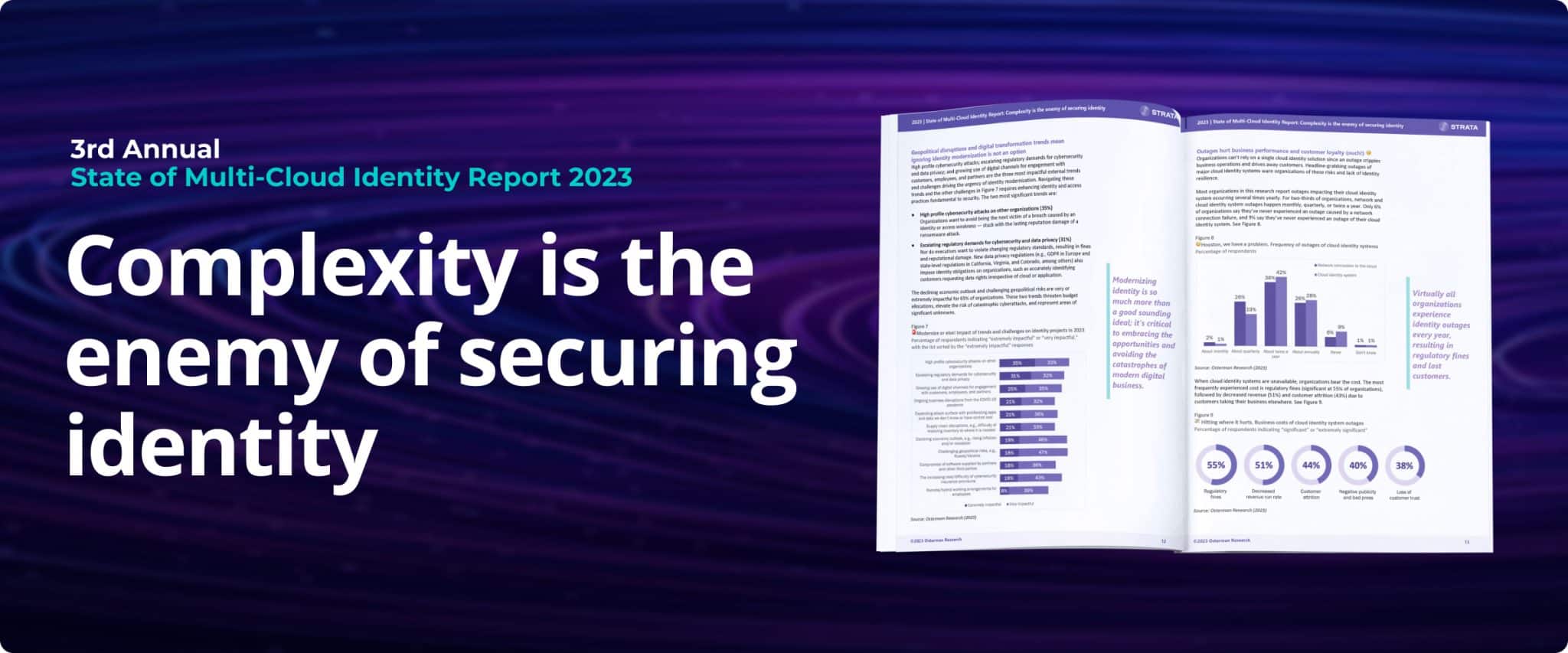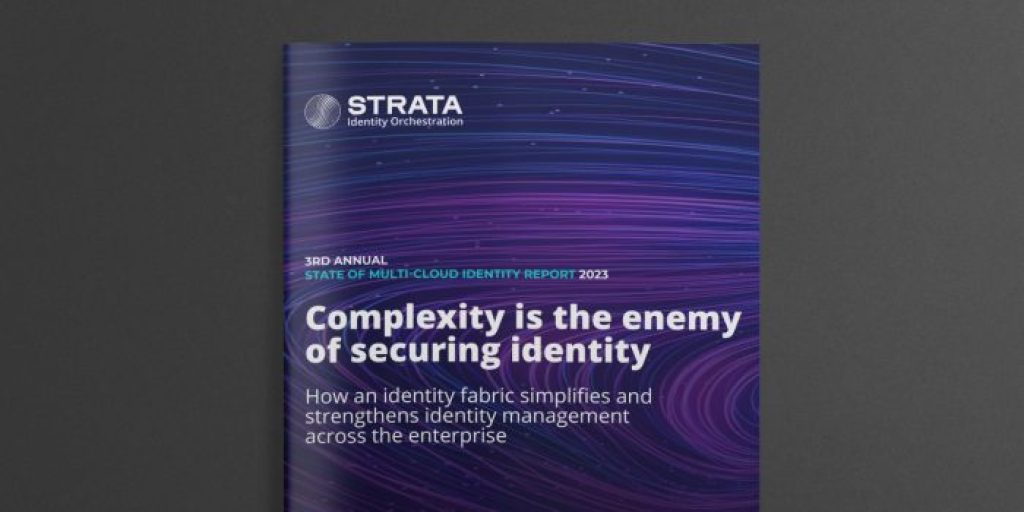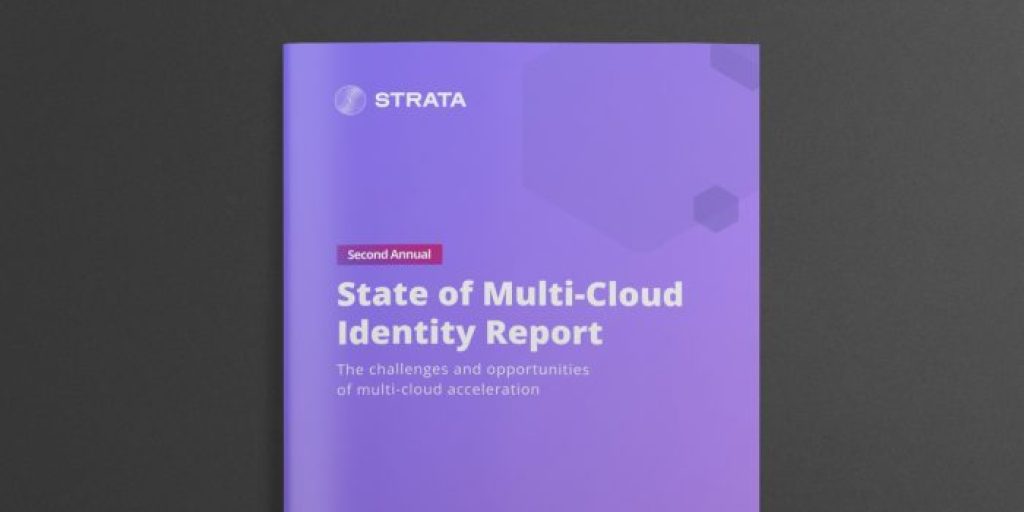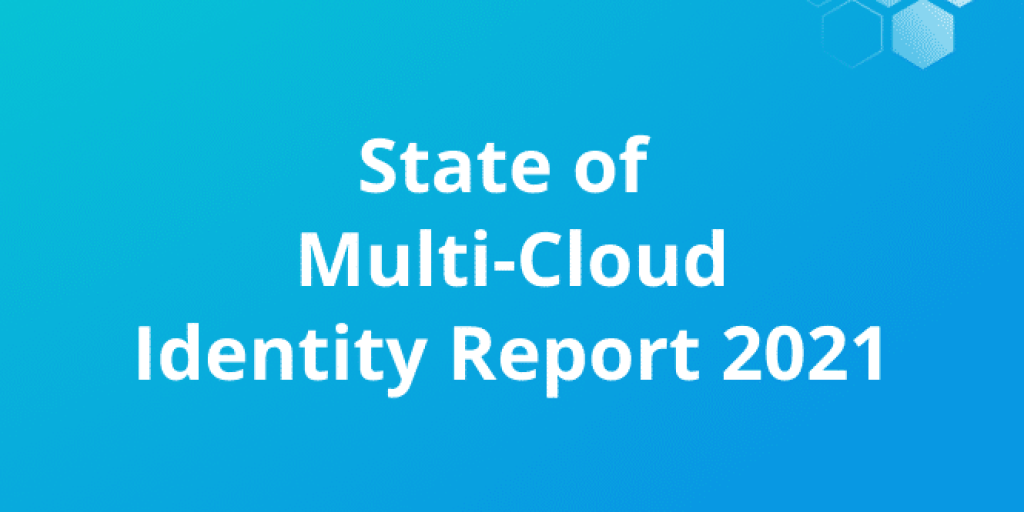Highlights from the State of Multi-Cloud Identity Report 2023

Key insights and highlights from the State of Multi-Cloud Identity Report 2023
As digital transformation rapidly reshapes the business landscape, multi-cloud strategies are becoming the norm for enterprises. An average of 80% of enterprises now use multiple clouds.
While a cloud-first approach is a dominant mindset, the reality is many enterprises still rely on a mix of traditional identity provider solutions, leading to a hybrid or multi-cloud environment.
The allure of flexibility and scalability drives multi-cloud adoption; however, that means managing identities across diverse platforms. The disparate identity systems in different clouds, as well as on-premises, create a highly fragmented identity landscape.
The 2023 State of Multi-Cloud Identity Report, commissioned by Strata Identity and conducted by Osterman Research, surveyed 308 IT leaders and decision-makers at North American organizations with annual revenues of US$100 million or more on their challenges and priorities for identity management in multi-cloud environments. The report offers a deep dive into the evolving challenges and solutions in enterprises’ Identity and Access Management (IAM) today.
Key insights from the State of Multi-cloud Identity Report 2023
As the multi-cloud movement gains momentum, businesses need help with the complexities of scattered identities, making the goal of a secure and seamless environment more elusive than ever before.
The following are four key insights to take note of:
- The Multi-cloud movement intensifies: The report highlights the acceleration of the multi-cloud movement, emphasizing the critical role of identity management in this transition.
- Identity fragmentation — a growing concern: As enterprises expand their cloud portfolios, the scattering of identities across platforms has become a significant issue. Fragmentation complicates the implementation of modern authentication methods, creating tall hurdles for maintaining a secure environment.
- The rise of Identity Orchestration: One of the emerging solutions is Identity Orchestration — a distributed abstraction layer that integrates multi-cloud and hybrid identity infrastructures, ensuring consistent identity and access policies across platforms.
- The promise of an identity fabric: The concept of an identity fabric is gaining traction. Similar to Gartner’s Cybersecurity Mesh Architecture, the identity fabric integrates various identity providers and services, creating a seamless and adaptable environment. This adaptability allows components to be modified or replaced without disrupting the entire system.
Digging deeper into the identity challenges
While the cloud offers numerous advantages, legacy systems and outdated IAM practices hinder the progress of organizations being able to go all-in with the cloud — at least not as quickly as they may like. The 2023 report underscores the scattered nature of identities and the challenges posed by current IAM standards, which often fall short of addressing the unique requirements of multi-cloud identity.
What are the challenges plaguing CISOs and identity practitioners?
Regarding cloud migration and management, the statistics surrounding identity challenges are staggering:
- Over 75% of enterprises do not know where applications are deployed and who has access.
- 67% of respondents face difficulties managing fragmented apps and identities across various cloud platforms, while 65% express cybersecurity concerns.
- Data privacy and region-specific regulations are an issue for 56% of respondents, while legacy system dependencies hinder 54%.
- Other challenges include obtaining application owner buy-in (47%), resource constraints (44%), and the costs of modernizing apps for the cloud (34%).
How are companies addressing identity challenges?
In 2023, identity projects have seen a significant surge in investment, with a notable emphasis on modernizing outdated systems. A striking 34% of organizations are channeling more funds into migrating from legacy identity systems to modern providers, driven by the need for enhanced security, resilience, and adaptability.
Increase in identity governance and regulatory compliance spending
In addition, 32% of respondents prioritize investments in identity governance and regulatory compliance to ensure clarity in identity rights, streamline duties, and leverage analytics, all aiming to ease the pitfalls of identity disorder and hefty non-compliance fines.
The push towards modern authentication methods, such as passwordless and multi-factor authentication (MFA), is gaining traction. An average of 26% of organizations plan to increase their budgets to get ahead of cybersecurity threats by implementing advanced cybersecurity techniques across all platforms, including traditionally “unmanageable apps.” This shows the increased importance of MFA.
Is hiring more people to manage enterprise identity the answer?
As much as they’d like to try, organizations can’t just hire their way out of the identity dilemma. Hiring more people sounds much easier in theory than in reality.
For example, 52% find it either “difficult” or “very difficult” to hire pros who can transform their ancient identity systems into the 21st century. Even more concerning, 60% lack the budget or resources to update their legacy apps. Meanwhile, a staggering 78% are tripping over all sorts of hurdles to modernize their identity systems.
Only a fortunate 22% have found the magical combination of “access to the source code for their applications, judge the deployment risk as manageable, and have available resources and time for implementing modern authentication for all applications.”
Identity transformation in a multi-cloud landscape
Time to talk about Identity Orchestration. Imagine a world where you can swiftly add or scrap identity services, all the while ensuring the best security possible. It’s like giving your on-premises apps a VIP pass to the modern cloud identity party.
The best part is the Identity Orchestration party lets enterprises dance smoothly across multiple cloud platforms. No more tripping over mismatched access policies or panicking during cloud outages.
With a new identity fabric, your old-school apps can join the cool kids with modern authentication moves like the MFA shuffle and the passwordless boogie. Plus, as the definition of “modern” keeps getting trendier, the identity fabric ensures your apps are always on the guest list.
Even better: no more hunting for those elusive identity specialists. With a no-code path, most security professionals can manage the show.
The power of Identity Orchestration
In the face of complex multi-cloud environments, Identity Orchestration is a powerful solution for organizations seeking to overcome identity fragmentation and enhance their security posture. Identity and cloud teams can achieve seamless and secure IAM across multiple cloud platforms by constructing an identity fabric through Identity Orchestration. It is possible to get all the benefits of multi-cloud while ensuring consistent access policies and robust security.
Deep-dive research and analysis are crucial for organizations to understand the challenges and opportunities related to multi-cloud identity management. The State of Multi-Cloud Identity Report for 2023 provides valuable insights and recommendations for organizations embarking on their multi-cloud journey.
The State of Multi-Cloud Identity Report 2023 — Complexity is the enemy of securing identity is available here.



